Sentinel-1 Data Processing for Detecting and Monitoring of Ground Instabilities in the Rocky Coast of Central Asturias (N Spain)
Abstract
1. Introduction
1.1. Background
1.2. Setting of the Study Area
2. Materials and Methods
2.1. A-DInSAR Processing
2.2. Local Areas Detection
- Salinas Town. With an area of 3.9 km2, it is highly anthropized and urbanized, encompassing the urban centers of Arnao, Salinas, and La Vallina, among others. Its maximum altitude is 85 m, and the coastal orientation is towards the North. There are 72 mass movements recorded in the BAPA database in this sector.
- Podes Peninsula. With an area of 2.8 km2, it is a predominantly rural area, with very few buildings. Its maximum altitude is 75 m, and the coast orientation is towards the North. Only one mass movement is registered in the BAPA database.
- Luanco Town. With an area of 8.1 km2, it includes the urban area of Luanco, the rest being predominantly rural. Its maximum altitude is 90 m, and the predominant coastal orientation is towards the East and North. Nine mass movements are recorded in the BAPA database in this sector.
- Candás Town. With an area of 7.5 km2, it includes the urban area of Candás and other small villages. Its maximum altitude is above 100 m, and the predominant coastal orientation is towards the Northeast. There are 37 mass movements recorded in this sector.
- Musel Port. With an area of 4.7 km2, it is located to the West of the city of Gijón. It is the most important and critical port infrastructure of Asturias. Its maximum altitude is 120 m, and the predominant coastal orientation is towards the East. Thirteen mass movements are recorded in this sector.
- Peñarrubia Beach. With an area of 11.6 km2, it is located in the East of the study area and is to the East of the city of Gijón. Its maximum altitude is 100m, and the predominant coastal orientation is towards the North. Twelve mass movements are recorded in this sector.
2.3. Interpretation of Regional and Local Dataset Acquired with A-DInSAR
- Aerial orthophotos acquired in 2017 (OrtoPNOA 2017 CC-BY 4.0 scne.es) with a pixel resolution of 0.25 m.
- Topographic maps of the Principality of Asturias at scale 1:25,000.
- Digital Terrain Models: Elevation, Slope, and Orientation with pixel resolution of 5 × 5 m.
- Soil and geological maps at 1:25,000 and 1:50.000 scales, respectively.
- Land use map of 2014 at scale 1:25,000 by SIOSE plan (Sistema de Información de Ocupación del Suelo en España- Land Occupation Information System in Spain).
3. Results
3.1. A-DInSAR at Regional Scale
3.2. A-DInSAR at Local Scale
4. Discussion
5. Conclusions
Author Contributions
Funding
Data Availability Statement
Acknowledgments
Conflicts of Interest
References
- Casu, F.; Elefante, S.; Imperatore, P.; Zinno, I.; Manunta, M.; De Luca, C.; Lanari, R. SBAS-DInSAR parallel processing for deformation time-series computation. IEEE J. Sel. Top. Appl. Earth Obs. Remote Sens. 2014, 7, 3285–3296. [Google Scholar] [CrossRef]
- Ferreti, A.; Prati, C.; Rocca, F. Nonlinear subsidence rate estimation using Permanent Scatterers in Differential SAR Interferometry. IEEE Trans. Geosci. Remote Sens. 2000, 38, 2202–2212. [Google Scholar] [CrossRef]
- Ferreti, A.; Prati, C.; Rocca, F. Permanent Scatterers in SAR interferometry. IEEE Trans. Geosci. Remote Sens. 2001, 39, 8–20. [Google Scholar] [CrossRef]
- Berardino, P.; Fornaro, G.; Lanari, R.; Sansosti, E. A New Algorithm for Surface Deformation Monitoring Based on Small Baseline Differential SAR Interferograms. IEEE Trans. Geosci. Remote Sens. 2002, 40, 2375–2383. [Google Scholar] [CrossRef]
- Crosetto, M.; Monserrat, O.; Cuevas-González, M.; Devanthéry, N.; Crippa, B. Persistent Scatterer Interferometry: A review. ISPRS J. Photogramm. Remote Sens. 2015, 115, 78–89. [Google Scholar] [CrossRef]
- Hooper, A.; Zebker, H.A.; Segall, P.; Kampes, B. A new method for measuring deformation on volcanoes and other natural terrains using InSAR persistent scatterers. Geophys. Res. Lett. 2004, 31, L23611. [Google Scholar] [CrossRef]
- De Novellis, V.; Carlino, S.; Castaldo, R.; Tramelli, A.; De Luca, C.; Pino, N.A.; Pepe, S.; Convertito, V.; Zinno, I.; De Martino, P.; et al. The 21 August 2017 Ischia (Italy) Earthquake Source Model Inferred From Seismological, GPS, and DInSAR Measurements. Geophys. Res. Lett. 2017, 45, 2193–2202. [Google Scholar] [CrossRef]
- Béjar-Pizarro, M.; Álvarez-Gómez, J.A.; Staller, A.; Luna, M.P.; Pérez-López, R.; Monserrat, O.; Chunga, K.; Lima, A.; Galve, J.P.; Martínez-Díaz, J.J.; et al. InSAR-Based Mapping to Support Decision-Making after an Earthquake. Remote Sens. 2018, 10, 899. [Google Scholar] [CrossRef]
- Raucoules, D.; Colesanti, C.; Carnec, C. Use of SAR interferometry for detecting and assessing ground subsidence. Comptes Rendus Geosci. 2007, 339, 289–302. [Google Scholar] [CrossRef]
- Sanabria, M.P.; Guardiola-Albert, C.; Tomás, R.; Herrera, G.; Prieto, A.; Sánchez, H.; Tessitore, S. Subsidence activity maps derived from DInSAR data: Orihuela case study. Nat. Hazards Earth Syst. Sci. 2014, 14, 1341–1360. [Google Scholar] [CrossRef]
- Solari, L.; Ciampalini, A.; Raspini, F.; Bianchini, S.; Moretti, S. PSInSAR Analysis in the Pisa Urban Area (Italy): A Case of Study of Subsidence Related to Stratigraphical Factors and Urbanization. Remote Sens. 2016, 8, 120. [Google Scholar] [CrossRef]
- Solari, L.; Del Soldato, M.; Bianchini, S.; Ciampalini, A.; Ezquerro, P.; Montalti, R.; Raspini, F.; Moretti, S. From ERS 1/2 to Sentinel-1: Subsidence Monitoring in Italy in the Last Two Decades. Front. Earth Sci. 2018, 6, 149. [Google Scholar] [CrossRef]
- Cascini, L.; Fornaro, G.; Peduto, D. Advanced low- and full-resolution DInSAR map generation for slow-moving landslide analysis at different scales. Eng. Geol. 2010, 112, 29–42. [Google Scholar] [CrossRef]
- Bianchini, S.; Herrera, G.; Mateos, R.M.; Notti, D.; Garcia, I.; Mora, O.; Moretti, S. Landslide Activity Maps Generation by Means of Persistent Scatterer Interferometry. Remote Sens. 2013, 5, 6198–6222. [Google Scholar] [CrossRef]
- Herrera, G.; Gutiérrez, F.; García-Davalillo, J.C.; Guerrero, J.; Notti, D.; Galve, J.P.; Fernández-Merodo, J.A.; Cooksley, G. Multi-sensor advanced DInSAR monitoring of very slow landslides: The Tena Valley case study (Central Spanish Pyrenees). Remote Sens. Environ. 2013, 128, 31–43. [Google Scholar] [CrossRef]
- Barra, A.; Monserrat, O.; Mazzanti, P.; Esposito, C.; Crosetto, M.; Scarascia-Mugnozza, G. First insights on the potential of Sentinel-1 for landslides detection. Geomat. Nat. Hazards Risk 2016, 7, 1874–1883. [Google Scholar] [CrossRef]
- Bell, J.W.; Amelung, F.; Ferreti, A.; Bianchi, M.; Novali, F. Permanent Scatterer InSAR reveals seasonal and long-term aquifer-system response to groundwater pumping and artificial recharge. Water Resour. Res. 2008, 44, W02407. [Google Scholar] [CrossRef]
- Béjar-Pizarro, M.; Ezquerro, P.; Herrera, G.; Tomás, R.; Guardiola-Albert, C.; Ruíz Hernández, J.M.; Fernández Merodo, J.A.; Marchamalo, M.; Martínez, R. Mapping groundwater level and aquifer storage variations from InSAR measurements in the Madrid aquifer, Central Spain. J. Hydrol. 2017, 547, 678–689. [Google Scholar] [CrossRef]
- Haghighi, M.H.; Motagh, M. Ground surface response to continuous compaction of aquifer system in Tehran, Iran: Results from a long-term multi-sensor InSAR analysis. Remote Sens. Environ. 2019, 221, 534–550. [Google Scholar] [CrossRef]
- Perissin, D.; Wang, Z.; Lin, H. Shangai subway tunnels and highways monitoring through Cosmo-SkyMed Persistent Scatterers. ISPRS J. Photogram. Remote Sens. 2012, 73, 58–67. [Google Scholar] [CrossRef]
- Del Soldato, M.; Tomás, R.; Pont, J.; Herrera, G.; García-Davalillos, J.C.; Mora, O. A multi-sensor approach for monitoring a road bridge in the Valencia harbour (SE Spain) by SAR Interferometry (InSAR). Rend. Online Della Soc. Geol. Ital. 2016, 41, 235–238. [Google Scholar] [CrossRef]
- Chang, L.; Dollevoet, R.P.; Hanssen, R.F. Nationwide Railway Monitoring Using Satellite SAR Interferometry. IEEE J. Sel. Top. Appl. Earth Obs. Remote Sens. 2017, 10, 596–604. [Google Scholar] [CrossRef]
- Barra, A.; Solari, L.; Béjar-Pizarro, M.; Monserrat, O.; Bianchini, S.; Herrera, G.; Crosetto, M.; Sarro, R.; González-Alonso, E.; Mateos, R.M.; et al. Methodology to Detect and Update Active Deformation Areas Based on Sentinel-1 SAR Images. Remote Sens. 2017, 9, 1002. [Google Scholar] [CrossRef]
- Rott, H. Advances in interferometric synthetic aperture radar (InSAR) in earth system science. PPG Earth Environ. 2009, 33, 769–791. [Google Scholar] [CrossRef]
- Sunamura, T. Geomorphology of Rocky Coasts; John Wiley and Sons: Chichester, UK, 1992; p. 302. [Google Scholar]
- Trenhaile, A.S. Modeling the development of marine terraces on tectonically mobile rock coasts. Mar. Geol. 2002, 185, 341–361. [Google Scholar] [CrossRef]
- Gómez-Puyol, L.; Pérez-Alberti, A.; Blanco-Chao, R.; Costa, S.; Neves, M.; Del Río, L. The rock coast of continental Europe in the Atlantic. In Rock Coast Geomorphology: A Global Synthesis; Kennedy, D.M., Stephenson, W.J., Naylor, L., Eds.; Geological Society London Memoirs: London, UK, 2014; Volume 40, pp. 77–87. [Google Scholar]
- Flor, G.; Flor-Blanco, G.; Rey, J. Dynamics and morpho-sedimentary interactions in the lower mesotidal estuary of Villaviciosa (NW Spain): A management proposal. Geol. Acta 2015, 13, 107–121. [Google Scholar] [CrossRef]
- Trenhaile, A. Rocky coasts—their role as depositional environments. Earth Sci. Rev. 2016, 159, 1–13. [Google Scholar] [CrossRef]
- Epifânio, B.; Zêzere, J.L.; Neves, M. Identification of hazardous zones combining cliff retreat rates with landslide susceptibility assessment. J. Coast. Res. 2013, 65, 1681–1686. [Google Scholar] [CrossRef]
- Michoud, C.; Carrea, D.; Costa, S.; Derron, M.H.; Jaboyedoff, M.; Delacourt, C.; Maquaire, O.; Letortu, P.; Davidson, R. Landslide detection and monitoring capability of boat-based mobile laser scanning along Dieppe coastal cliffs, Normandy. Landslides 2015, 12, 403–418. [Google Scholar] [CrossRef]
- Boualla, O.; Mehdi, K.; Fadili, A.; Makan, A.; Zourarah, B. GIS-based landslide susceptibility mapping iin the Safi region, West Morocco. Bull. Eng. Geol. Environ. 2019, 78, 2009–2026. [Google Scholar] [CrossRef]
- Horacio, J.; Muñoz-Narciso, E.; Trenhaile, A.; Pérez-Alberti, A. Remote sensing monitoring of a coastal-valley earthflow in northwestern Galicia, Spain. Catena 2019, 178, 276–287. [Google Scholar] [CrossRef]
- Notti, D.; Galve, J.P.; Mateos, R.M.; Monserrat, O.; Lamas-Fernández, F.; Fernández-Chacón, F.; Roldán-García, F.J.; Pérez-Peña, J.V.; Crosetto, M.; Azañón, J.M. Human-induced coastal Landslide reactivation. Monitoring by PSInSAR techniques and urban damage survey (SE Spain). Landslides 2015, 12, 1007–1014. [Google Scholar] [CrossRef]
- Cigna, F.; Banks, V.; Donald, A.W.; Donohue, S.; Graham, C.; Hughes, D.; McKinley, J.M.; Parker, K. Mapping Ground Instability in Areas of Geotechnical Infraestructure Using Satellite InSAR and Small UAV Surveying: A Case Study in Northern Ireland. Geosciences 2017, 7, 51. [Google Scholar] [CrossRef]
- Mateos, R.M.; Ezquerro, P.; Azañón, J.M.; Gelabert, B.; Herrera, G.; Fernández-Merodo, J.A.; Spizzichino, D.; Sarro, R.; García-Moreno, I.; Béjar-Pizarro, M. Coastal lateral spreading in the world heritage site of the Tramuntana Range (Majorca, Spain). The use of PSInSAR monitoring to identify vulnerability. Landslides 2018, 15, 797–809. [Google Scholar] [CrossRef]
- Spinosa, A.; Ziemba, A.; Saponieri, A.; Navarro-Sanchez, V.D.; Damiani, L.; El Serafy, G. Automatic Extraction of Shoreline from Satellite Images: A new approach. In Proceedings of the IEEE International Workshop on Metrology for the Sea; Learrning to Measure Sea Health Parameters (MetroSea) 2018, Bari, Italy, 8–10 October 2018; pp. 33–38. [Google Scholar] [CrossRef]
- Solari, L.; Barra, A.; Herrera, G.; Bianchini, S.; Monserrat, O.; Béjar-Pizarro, M.; Crosetto, M.; Sarro, R.; Moretti, S. Fast detection of ground motions on vulnerable elements using Sentinel-1 InSAR data. Geomat. Nat. Hazards Risk 2018, 9, 152–174. [Google Scholar] [CrossRef]
- Atanasova, M.; Nikolov, H. Detection of ground motions in coastal area. In Proceedings of the XXIX International Symposium on “Modern Technologies, Education and Professional Practice in Geodesy and Related Fields” 2019, Istanbul, Turkey, 5–6 November 2019. [Google Scholar] [CrossRef]
- Yu, L.; Yang, T.; Zhao, Q.; Liu, M.; Pepe, A. The 2015-2016 Ground Displacements of the Shangai Coastal Area Inferred from a Combined COSMO-SkyMed/Sentinel-1 DInSAR Analysis. Remote Sens. 2017, 9, 1194. [Google Scholar] [CrossRef]
- Krishnan, S.; Kim, D.; Jung, J.; Cho, Y.K. Application of PS-InSAR Technique for Measuring the Coastal Subsidence in the East Coast of South Korea. In Proceedings of the URSI Asia-Pacific Radio Science Conference 2019, New Delhi, India, 9–15 March 2019. [Google Scholar] [CrossRef]
- Cian, F.; Delgado-Blasco, J.M.; Carrera, L. Sentinel-1 for Monitoring Land Subsidence of Coastal Cities in Africa Using PSInSAR: A Methodology Based on the Integration of SNAP and StaMPS. Geosciences 2019, 9, 124. [Google Scholar] [CrossRef]
- Domínguez-Cuesta, M.J.; Jiménez-Sánchez, M.; González-Fernández, J.A.; Quintana, L.; Flor, G.; Flor-Blanco, G. GIS as a tool to detect flat erosional surfaces in coastal areas: A case study in North Spain. Geol. Acta 2015, 13, 97–106. [Google Scholar] [CrossRef]
- Domínguez-Cuesta, M.J.; Valenzuela, P.; Rodríguez-Rodríguez, L.; Ballesteros, D.; Jiménez-Sánchez, M.; Piñuela, L.; García-Ramos, J.C. Cliff Coast of Asturias. In The Spanish Coastal System. Dynamic Processes, Sediments and Management; Morales, J.A., Ed.; Springer Nature Switzerland AG: Cham, Switzerland, 2019; pp. 49–77. [Google Scholar] [CrossRef]
- Domínguez-Cuesta, M.J.; Ferrer-Serrano, A.; Rodríguez-Rodríguez, L.; López-Fernández, C.; Jiménez-Sánchez, M. Análisis del retroceso de la costa cantábrica en el entorno del Cabo Peñas (Asturias, N España). Geogaceta 2020, 68, 63–66. [Google Scholar]
- Valenzuela, P.; Domínguez-Cuesta, M.J.; Mora, M.; Jiménez-Sánchez, M.A. spatio-temporal Landslide inventory for the NW of Spain: BAPA database. Geomorphology 2017, 293, 11–23. [Google Scholar] [CrossRef]
- Canuti, P.; Casagli, N.; Ermini, L.; Fanti, R.; Farina, P. Landslide activity as a geoindicator in Italy: Significance and new perspectives from remote sensing. Environ. Geol. 2004, 45, 907–919. [Google Scholar] [CrossRef]
- Instituto Nacional de Estadística (INE). Demografía y Población. Available online: https://www.ine.es/dyngs/INEbase/es/categoria.htm?c=Estadistica_P&cid=1254734710984 (accessed on 23 November 2020).
- Flor, G.; del Busto, J.A.; Flor-Blanco, G. Morphological and Sedimentary Patterns of Ports of the Asturian Region (NW Spain). J. Coast. Res. 2006, 48, 35–40. [Google Scholar]
- AEMET. Agencia Estatal de Meteorología. Available online: http://www.aemet.es/es/portada (accessed on 1 December 2020).
- Flor, G. Las Rasas Asturianas: Ensayos de Correlación y Emplazamiento. Trab. Geol. 1983, 13, 65–81. [Google Scholar]
- Flor, G.; Flor-Blanco, G. Raised beaches in the Cantabrian Coast. In Landscapes and Landsforms of Spain; Gutiérrez, F., Gutiérrez, M., Eds.; Springer Nature Switzerland AG: Chan, Switzerland, 2014; pp. 1–10. [Google Scholar] [CrossRef]
- Julivert, M. La estructura de la región de Cabo Peñas. Trab. Geol. 1976, 8, 203–309. [Google Scholar]
- Truyols, J.; Julivert, M. La sucesión paleozoica entre Cabo Peñas y Antromero (Cordillera Cantábrica). Trab. Geol. 1976, 8, 5–30. [Google Scholar]
- Arbizu, M.; Aller, J.; Méndez-Bedia, I. Rasgos geológicos de la región del Cabo Peñas. In Geología de Asturias, 1st ed.; Aramburu, C., Bastida, F., Eds.; Ediciones TREA S.L.: Gijón, Spain, 1995; pp. 231–246. [Google Scholar]
- Biescas, E.; Crosetto, M.; Agudo, M.; Monserrat, O.; Crippa, B. Two Radar Interferometric Approaches to Monitor Slow and Fast Land Deformation. J. Surv. Engrg. 2007, 133, 66–71. [Google Scholar] [CrossRef]
- Devanthéry, N.; Crosetto, M.; Monserrat, O.; Cuevas-González, M.; Crippa, B. An Approach to Persistent Scatterer Interferometry. Remote Sens. 2014, 6, 6662–6679. [Google Scholar] [CrossRef]
- Devanthéry, N.; Crosetto, M.; Monserrat, O.; Crippa, B.; Mróz, M. Data analysis tools for persistent scatterer interferometry based on Sentinel-1 data. Eur. J. Remote Sens. 2019, 52, 15–25. [Google Scholar] [CrossRef]
- Galve, J.P.; Pérez-Peña, J.V.; Azañón, J.M.; Closson, D.; Caló, F.; Reyes-Carmona, C.; Jabaloy, A.; Ruano, P.; Mateos, R.M.; Notti, D.; et al. Evaluation of the SBAS InSAR Service of the European Space Agency´s Geohazard Exploitation Platform (GEP). Remote Sens. 2017, 9, 1291. [Google Scholar] [CrossRef]
- Geohazards-TEP. Geohazard Exploitation Platform. Available online: https://geohazards-tep.eu/#! (accessed on 1 December 2020).
- Meisina, C.; Zucca, F.; Notti, D.; Colombo, A.; Cucchi, A.; Savio, G.; Giannico, C.; Bianchi, M. Geological Interpretation of PSInSAR Data at Regional Scale. Sensors 2008, 8, 7469–7492. [Google Scholar] [CrossRef]
- Manunta, M.; Bonano, M.; Buonanno, S.; Casu, F.; De Luca, C.; Fusco, A.; Lanari, R.; Manzo, M.; Ojha, C.; Pepe, A.; et al. Unsupervised Parallel SBAS-DInSAR Chain for Massive and Systematic Sentinel-1 Data Processing. In Proceedings of the IEEE International Geoscience and Remote Sensing Symposium IGARSS, Beijing, China, 10–15 July 2016; pp. 3890–3893. [Google Scholar] [CrossRef]
- Uriel-Ortiz, A. Patología de las cimentaciones. Inf. Construcción 1983, 35, 5–35. [Google Scholar] [CrossRef]
- Almazán-Gárate, J.L.; Palomino-Monzón, M.C. Introducción a la ingeniería Portuaria: Sistema Portuario Español. Obras Exteriores; Universidad Politécnica de Madrid: Madrid, Spain, 2000; pp. 11–16. [Google Scholar]
- Flor, G.; Flor-Blanco, G. An Introduction to the erosion and sedimentation problems in the coastal regions of Asturias and Cantabria (NW Spain) and its implications on environmental management. J. Coast. Res. 2005, 49, 58–63. [Google Scholar]
- Flor-Blanco, G.; Flor, G.; Pando, L. Evolution of the Salinas-El Espartal and Xagó beach/dune systems in north-western Spain over recent decades: Evidence for responses to natural processes and anthropogenic interventions. Geo Mar. Lett. 2013, 33, 143–157. [Google Scholar] [CrossRef]
- Colesanti, C.; Wasowski, J. Investigating landslides with space-borne Synthetic Aperture Radar (SAR) interferometry. Eng. Geol. 2006, 88, 173–199. [Google Scholar] [CrossRef]
- Zhao, Q.; Lin, H.; Gao, W.; Zebker, H.A.; Chen, A.; Yeung, K. InSAR detection of residual settlement of an ocean reclamation engineering project: A case study of Hong Kong International Airport. J. Oceanogr. 2011, 67, 415–426. [Google Scholar] [CrossRef]
- Zhao, Q.; Pepe, A.; Gao, W.; Lu, Z.; Bonano, M.; He, M.L.; Wang, J.; Tang, X. A DInSAR Investigation of the Ground Settlement Time Evolution of Ocean-Reclaimed Lands in Shangai. IEEE J. Sel. Top. Appl. Earth Obs. Remote Sens. 2015, 8, 1763–1781. [Google Scholar] [CrossRef]
- Navarro, J.A.; Tomás, R.; Barra, A.; Pagán, J.I.; Reyes-Carmona, C.; Solari, L.; Vinielles, J.L.; Falco, S.; Crosetto, M. ADAtools: Automatic Detection and Classification of Active Deformation Areas from PSI Displacement Maps. ISPRS Int. J. Geo Inf. 2020, 9, 584. [Google Scholar] [CrossRef]
- Bianchini, S.; Herrera, G.; Mateos, R.M.; García-Moreno, I.; Mora, O.; Sanchez, C.; Sanabria, M.; López, M.; Merodo, J.A.; Hernández, M.; et al. Metodología para mejorar el análisis de datos satélite radar en el estudio de los movimientos de ladera: Resultados del proyecto FP7 DORIS en la Serra de Tramuntana (Mallorca). In Proceedings of the VIII Simposio Nacional sobre Taludes y Laderas Inestables, Palma de Mallorca, Spain, 11–14 June 2013. [Google Scholar]
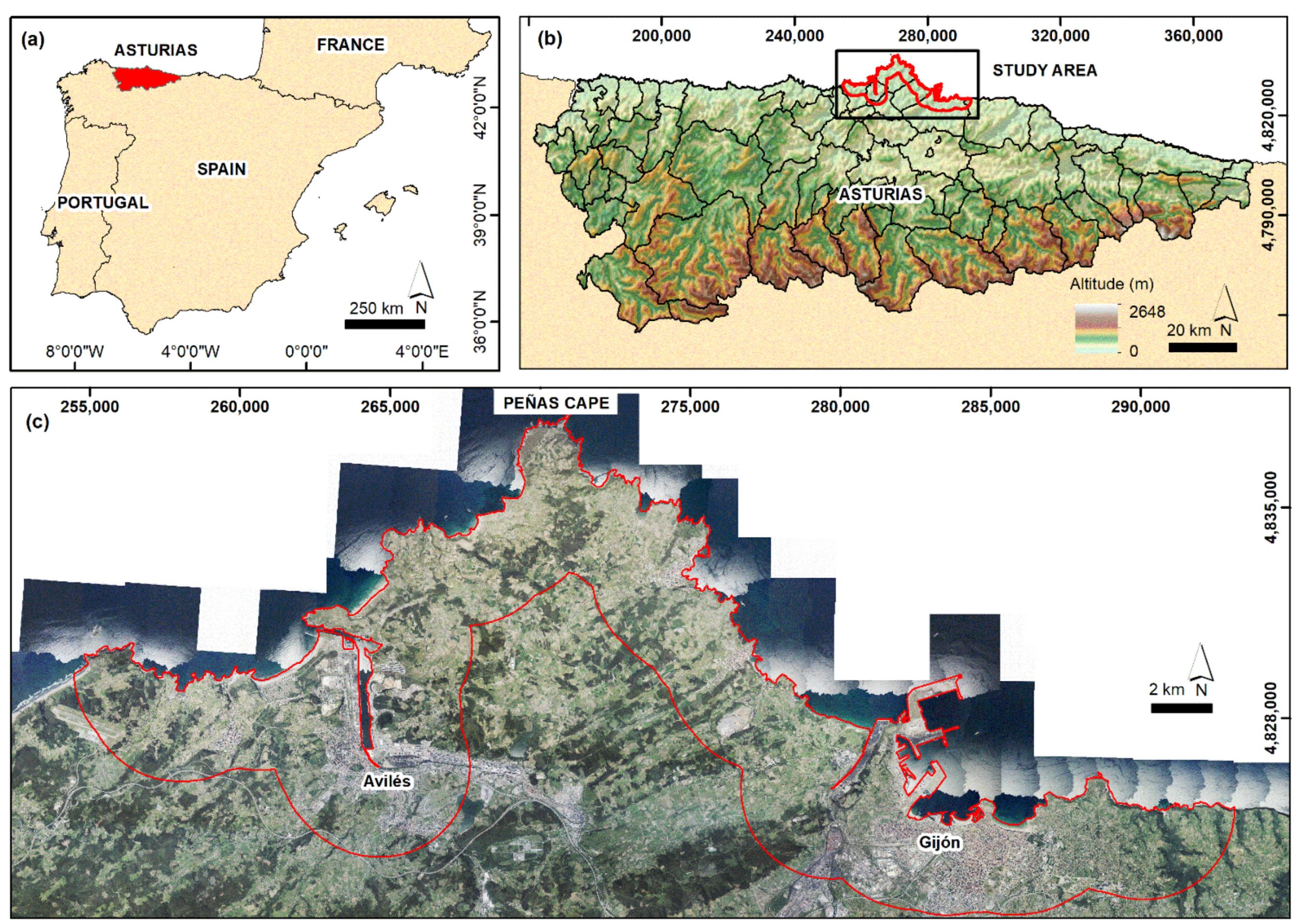
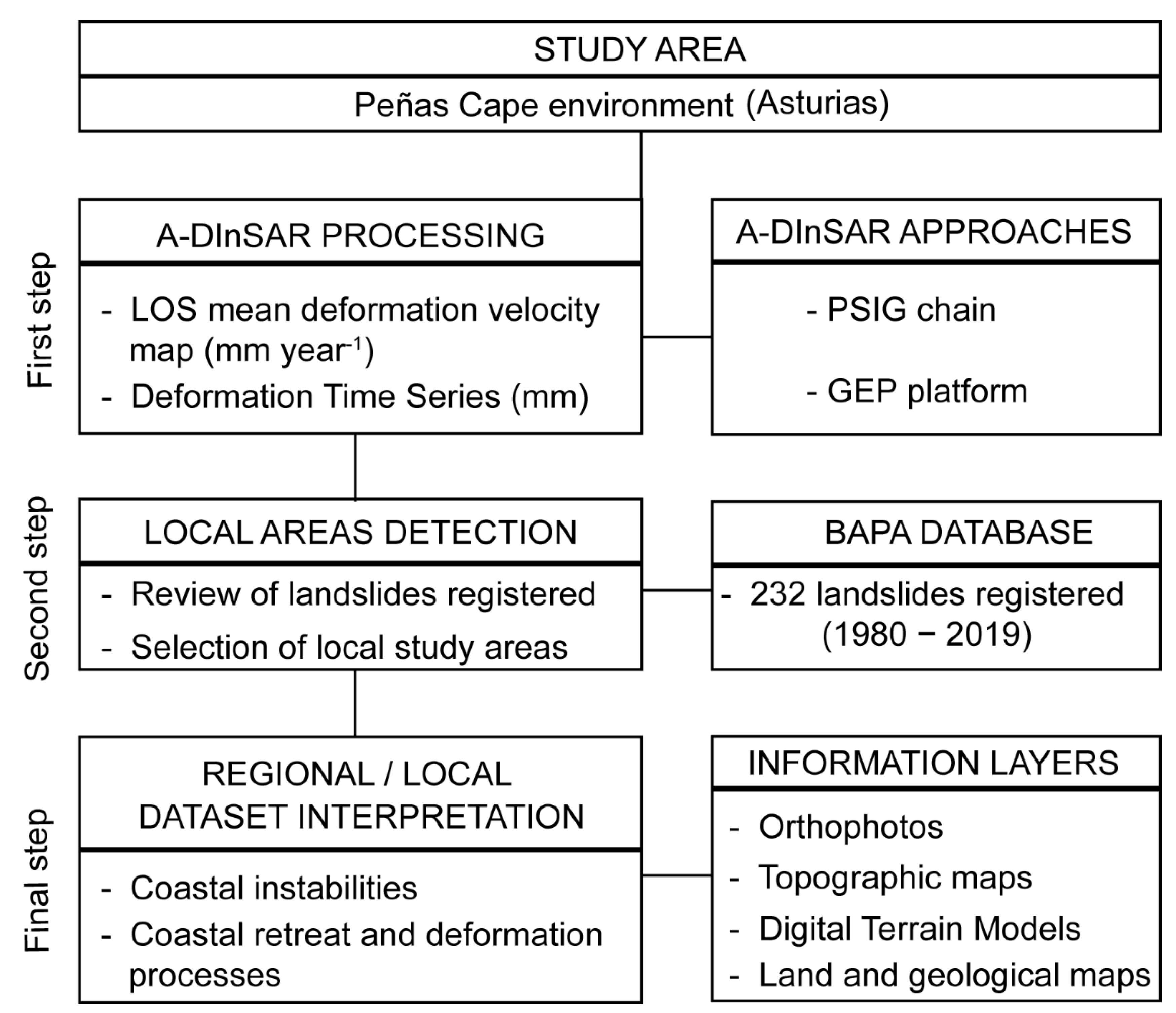
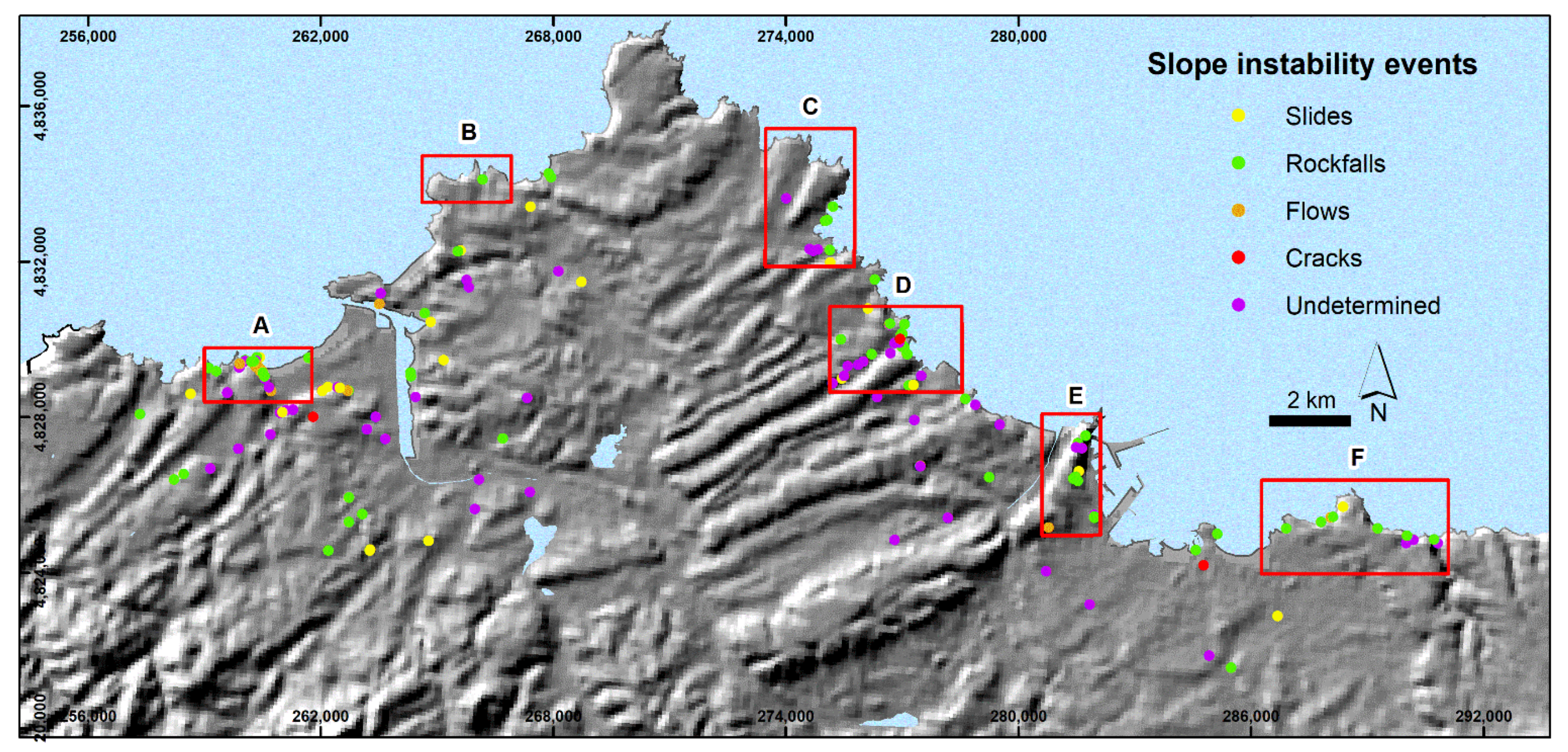
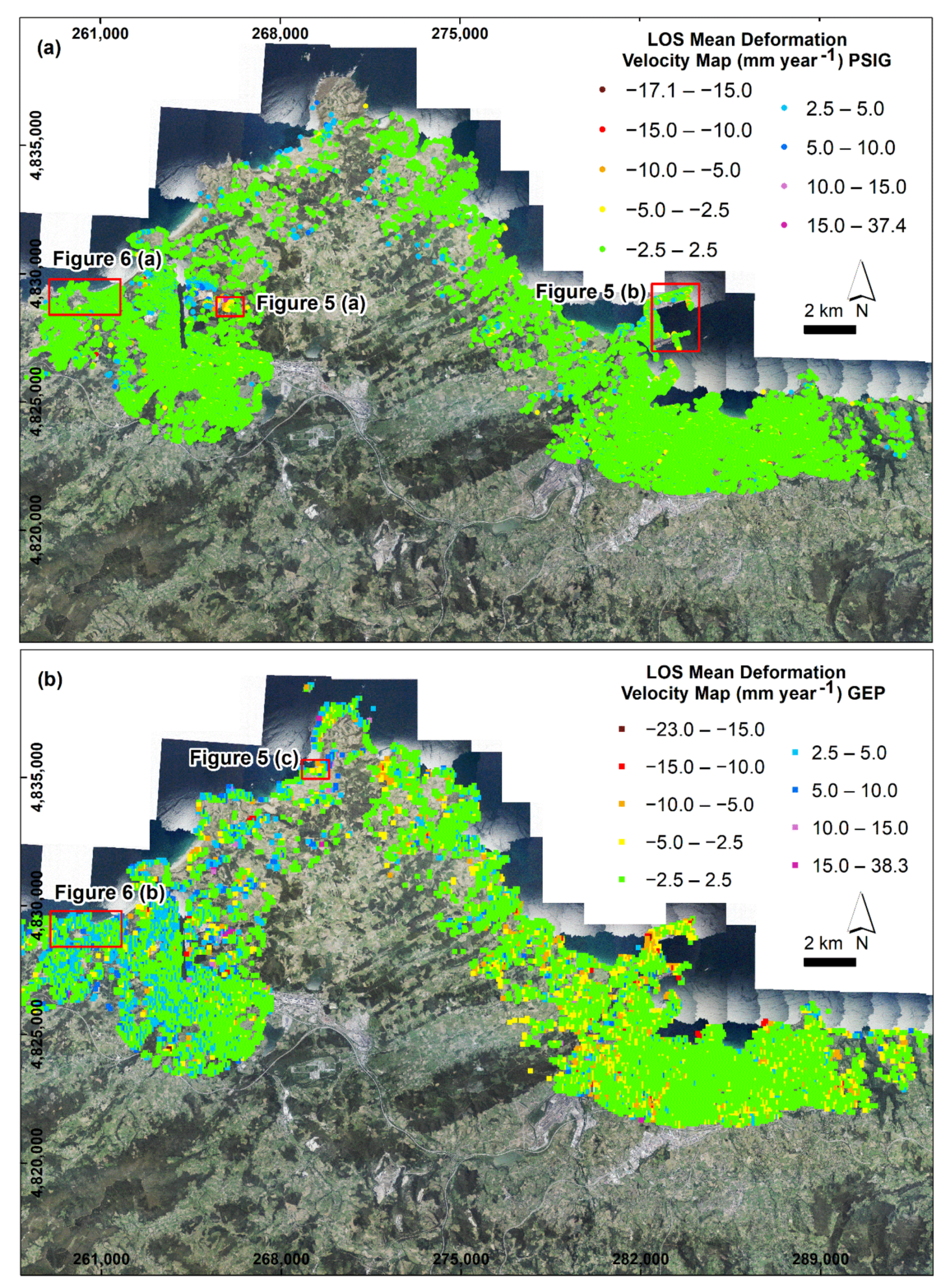

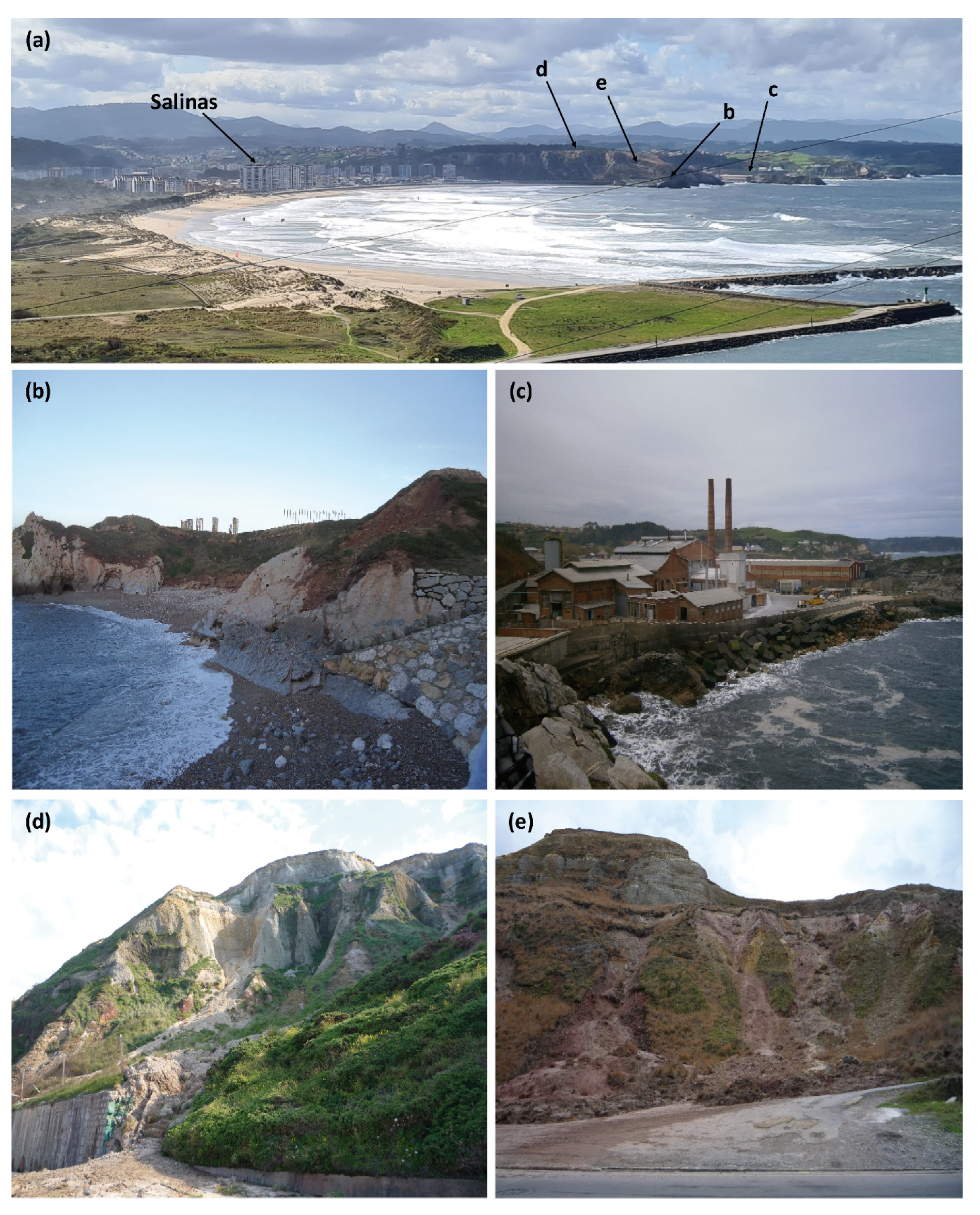

| Satellite | Sentinel-1 | |
|---|---|---|
| Sensor | A/B | |
| Band | C | |
| Wavelength | 5.55 cm | |
| Acquisition mode | Wide Swath | |
| Polarization | VV | |
| SAR product | Single Look Complex | |
| Acquisition orbit | Descending | |
| Temporal period | 4 January 2018–5 February 2020 | |
| Revisit period | 6–12 days | |
| Resolution | 14 × 4 m | |
| Incidence angle | 39° | |
| Track | 154 | |
| Number of SAR images | 113 | |
| Processing Parameters | PSIG | GEP |
| A-DInSAR technique | PSI | P-SBAS |
| Pixel Resolution | 14 × 4 m | 90 × 90 m |
| Pixel selection criteria | Amplitude | Coherence |
| Reference Point | −5.862760/43.364576 | −5.8430905/43.368119 |
| Used DEM | SRTM_35_04 (90 m) | SRTM_1arcsec (30 m) |
| Multilooking Factor | 1 × 1 (Azimuth × Range) | 5 × 20 (Azimuth × Range) |
| Applied Filter | LPS | APS |
| STUDY AREA | PSIG Software | GEP Service | |
|---|---|---|---|
| Number of points (PS) | 151,722 | 16,654 | |
| Density of points (PS km−2) | 811.3 | 89.1 | |
| LOS velocity (mm year−1) | |||
| Mean | 0.0 | 0.0 | |
| Maximum | 37.4 | 38.3 | |
| Minimum | −17.1 | −23.0 | |
| Standard deviation | 1.1 | 2.6 | |
| Accumulated LOS deformation (mm) | |||
| Mean | 0.1 | 1.1 | |
| Maximum | 78.8 | 77.0 | |
| Minimum | −68.5 | −48.8 | |
| Standard deviation | 3.6 | 5.1 | |
| LOS Rates PSIG (mm Year−1) | PSIG PS–% | LOS Rates GEP (mm Year−1) | PS–% GEP |
| <−10.0 | 15–0.010 | <−10.0 | 49–0.29 |
| −10.0–−5.0 | 184–0.12 | −10.0–−5.0 | 513–3.08 |
| −5.0–−2.5 | 2049–1.35 | −5.0–−2.5 | 1295–7.78 |
| −2.5–2.5 | 146,855–96.79 | −2.5–2.5 | 16,654–74.53 |
| 2.5–5.0 | 2426–1.60 | 2.5–5.0 | 1956–11.74 |
| 5.0–10.0 | 167–0.11 | 5.0–10.0 | 385–2.31 |
| >10.0 | 26–0.02 | >10.0 | 43–0.26 |
| Local Areas | Area km2 | PS km−2 | PS km−2 | PSIG Software | GEP Service | ||||
|---|---|---|---|---|---|---|---|---|---|
| PSIG | GEP | #PS | VLOS | TS | #PS | VLOS | TS | ||
| Salinas town | 3.9 | 876.2 | 117.7 | 3417 | −10.9−4.6 | −27.6–23.5 | 459 | −7.4–9.8 | −17.1–18.9 |
| Podes Peninsula | 2.8 | 8.9 | 30.4 | 25 | 1.5–4.5 | 1.6–10.7 | 85 | −6.8–12.9 | −13.7–28.9 |
| Luanco town | 8.1 | 509.5 | 64.7 | 4127 | −4.6–7.4 | −28.0–27.0 | 524 | −10.9–8.9 | −15.1–19.0 |
| Candás town | 7.5 | 479.7 | 60.9 | 3598 | −4.7–6.2 | −27.7–22.2 | 457 | −11.6–9.1 | −18.6–18.7 |
| Musel Port | 4.7 | 850.0 | 102.6 | 3995 | −17.1–6.0 | −53.6–33.6 | 482 | −12.3–9.7 | −26.8–32.1 |
| Peñarrubia Beach | 11.6 | 364.0 | 63.9 | 4222 | −6.3–4.6 | −22.3–23.7 | 741 | −12.6–8.7 | −28.0–15.4 |
| LOS Mean Velocity Rates (mm Year−1) | PS–% PSIG | PS–% GEP |
|---|---|---|
| <−2.5 | 11–0.3 | 8–1.7 |
| −2.5–2.5 | 3360–98.3 | 284–61.9 |
| > 2.5 | 46–1.4 | 167–36.4 |
| Sector | Maximum Coastal Retreat Rate (m Year−1) | LOS Velocity (mm Year−1) | LOS Displacement (mm) | ||
|---|---|---|---|---|---|
| PSIG | GEP | PSIG | GEP | ||
| Podes Peninsula | 0.71 | No data | −6.8–12.9 | No data | −13.7–28.9 |
| Luanco town | 1.22 | −2–3.7 | −9.1–7.5 | −15.8–26.6 | −12.9–16.3 |
| Candás town | 0.78 | −1.7–1.2 | −5.6–7.5 | −3.9–10.1 | −8.9–10.4 |
Publisher’s Note: MDPI stays neutral with regard to jurisdictional claims in published maps and institutional affiliations. |
© 2021 by the authors. Licensee MDPI, Basel, Switzerland. This article is an open access article distributed under the terms and conditions of the Creative Commons Attribution (CC BY) license (https://creativecommons.org/licenses/by/4.0/).
Share and Cite
Cuervas-Mons, J.; Domínguez-Cuesta, M.J.; Mateos Redondo, F.; Barra, A.; Monserrat, O.; Valenzuela, P.; Jiménez-Sánchez, M. Sentinel-1 Data Processing for Detecting and Monitoring of Ground Instabilities in the Rocky Coast of Central Asturias (N Spain). Remote Sens. 2021, 13, 3076. https://doi.org/10.3390/rs13163076
Cuervas-Mons J, Domínguez-Cuesta MJ, Mateos Redondo F, Barra A, Monserrat O, Valenzuela P, Jiménez-Sánchez M. Sentinel-1 Data Processing for Detecting and Monitoring of Ground Instabilities in the Rocky Coast of Central Asturias (N Spain). Remote Sensing. 2021; 13(16):3076. https://doi.org/10.3390/rs13163076
Chicago/Turabian StyleCuervas-Mons, José, María José Domínguez-Cuesta, Félix Mateos Redondo, Anna Barra, Oriol Monserrat, Pablo Valenzuela, and Montserrat Jiménez-Sánchez. 2021. "Sentinel-1 Data Processing for Detecting and Monitoring of Ground Instabilities in the Rocky Coast of Central Asturias (N Spain)" Remote Sensing 13, no. 16: 3076. https://doi.org/10.3390/rs13163076
APA StyleCuervas-Mons, J., Domínguez-Cuesta, M. J., Mateos Redondo, F., Barra, A., Monserrat, O., Valenzuela, P., & Jiménez-Sánchez, M. (2021). Sentinel-1 Data Processing for Detecting and Monitoring of Ground Instabilities in the Rocky Coast of Central Asturias (N Spain). Remote Sensing, 13(16), 3076. https://doi.org/10.3390/rs13163076







